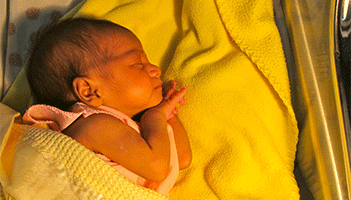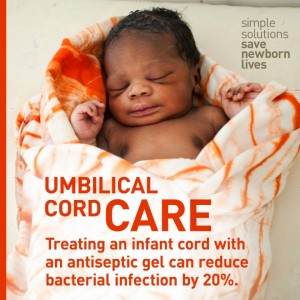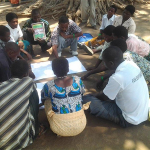New ‘Trending Topic’ Collection in Health COMpass: Chlorhexidine to Reduce Newborn Mortality
A baby’s first day of life should not be dangerous – but it is in countries that lack access to a simple antiseptic.
Every year, nearly 3 million babies die within the first month of life, with 1 million of these deaths occurring on the day of birth. Approximately 13% of these deaths are due to infection, and many of these infections come from the contamination of the umbilical cord. The newly cut umbilical cord is an entry point for bacteria that can quickly colonize and spread to the surrounding tissues and blood stream. Ensuring optimal cord care at birth and in the first week of life, especially is settings with poor hygiene, is thus a crucial strategy for saving newborn lives. For many years, the World Health Organization (WHO) has recommended the use of antiseptics for cord care in poor hygiene settings, and in 2013, new guidelines strengthened that advice by specifically recommending the use of 7.1% chlorhexidine digluconate delivering 4% chlorhexidine.
Listed as one of the simple solutions to saving newborn lives by the Gates Foundation and included as a life-saving commodity by a UN Commission for women’s and children’s health, the use of chlorhexidine is catching on. With the potential to prevent hundreds of thousands of neonatal deaths annually, chlorhexidine represents a simple technology that works, with trials in Bangladesh, Nepal, and Pakistan showing it as an effective and inexpensive antiseptic for umbilical cord care.
In late 2011, Nepal became the first country to introduce chlorhexidine at scale for umbilical cord card. Many countries are now following Nepal’s lead and have begun pilot implementation plans for introducing chlorhexidine into their national health programs.
With the introduction of a new commodity comes the need to introduce a new health behavior- a minimum of one application of chlorhexidine to the umbilical stump following delivery. And with the introduction of a new health behavior comes the need for SBCC materials and tools not only for explaining how, where and when to use it but also for creating demand for and increasing use of this life saving gel or liquid.
In this Trending Topic: Chlorhexidine to Reduce Newborn Mortality, HC3’s Health COMpass team presents a few of the resources already available to help guide SBCC programming for chlorhexidine, from materials needed to train service providers on use to communication strategies for creating demand. As a “Trending Topic” just now catching on globally, many more materials are probably currently in the works. We welcome your submission of these resources to the Health COMpass and look forward to sharing experiences in developing quality SBCC materials for chlorhexidine and improving neonatal health.









Leave a Reply
Want to join the discussion?Feel free to contribute!